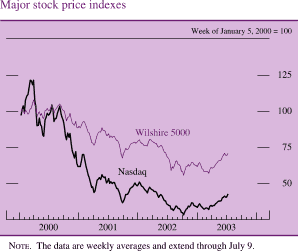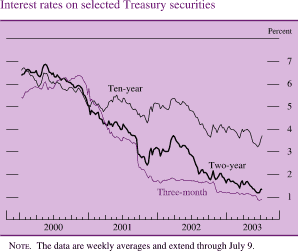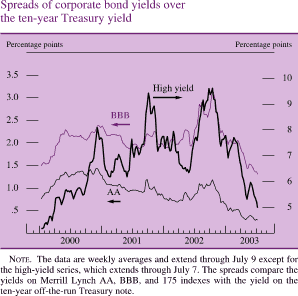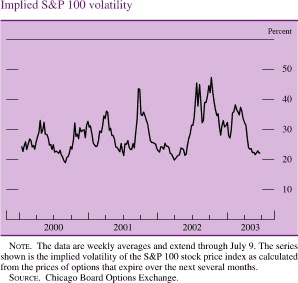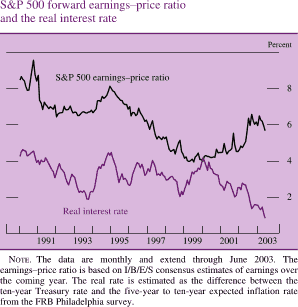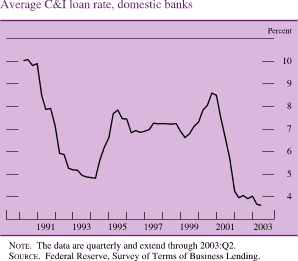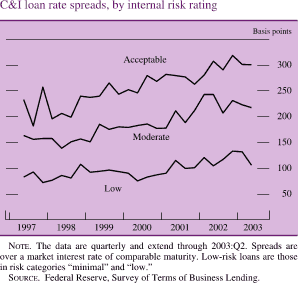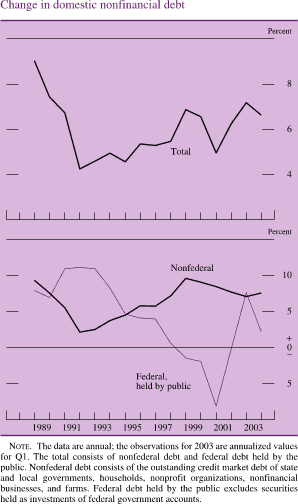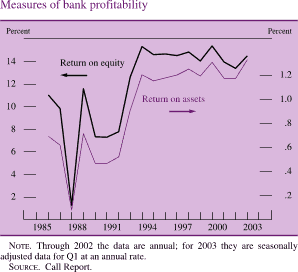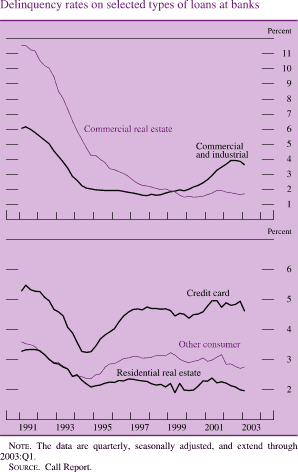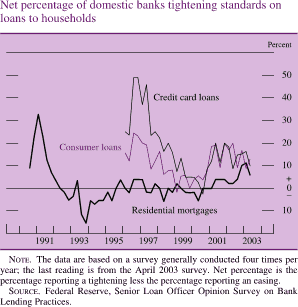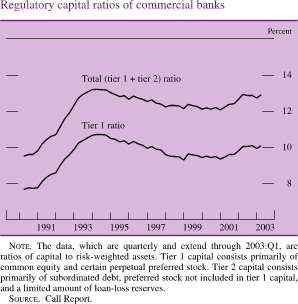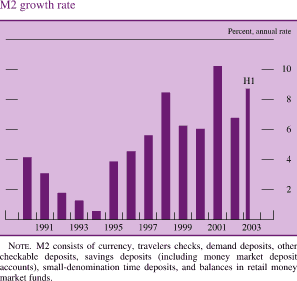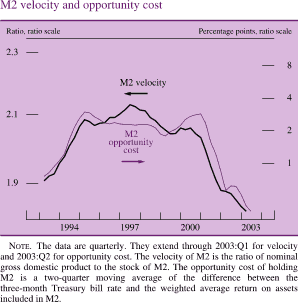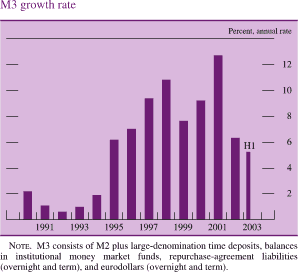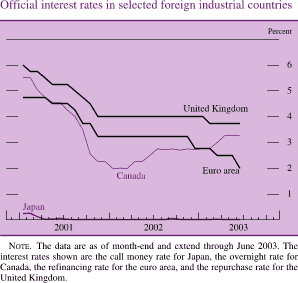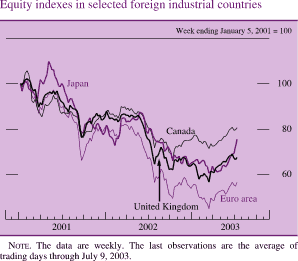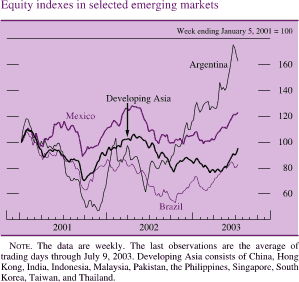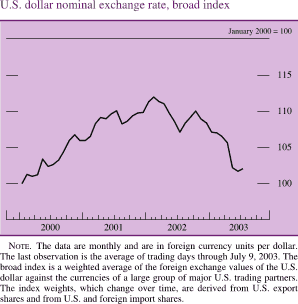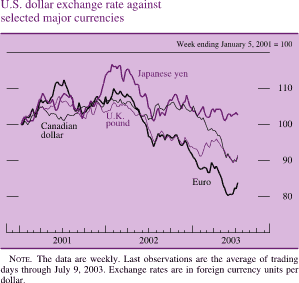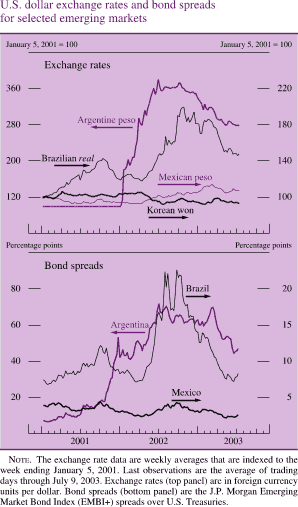
Monetary Policy Report submitted to the Congress on July 15, 2003, pursuant to section 2B of the Federal Reserve Act
Section 2
ECONOMIC AND FINANCIAL DEVELOPMENTS IN 2003
Economic activity in the United States remained sluggish in the first half of 2003. Businesses continued to be reluctant to undertake new projects given the unusual degree of uncertainty in the economic environment, and the softness in activity abroad crimped the demand for U.S. exports. However, consumer spending grew moderately, housing activity retained considerable vigor, and defense spending picked up. Real GDP rose at an annual rate of just 1-1/2 percent in the first quarter and appears to have posted another modest gain in the second quarter. With output growth remaining tepid and labor productivity rising at a fairly robust pace, firms continued to trim payrolls in the first half of 2003, though job losses in the private sector were a little smaller than they had been, on average, in 2002.
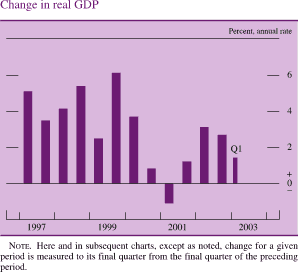
For much of the first half of the year, headline inflation news was shaped by movements in energy prices, which soared during the winter, retreated during the spring, and more recently firmed. Core inflation--which excludes the direct effects of food and energy prices--was held to a low level by slack in resource utilization and continued sizable advances in labor productivity.
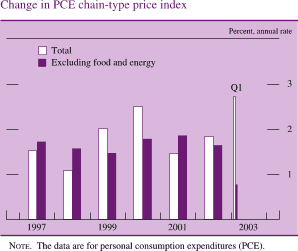
As a result of slow economic growth and the prospect that inflation would remain very subdued, the federal funds rate was maintained at the accommodative level of 1-1/4 percent for much of the first half of the year. Intermediate- and longer-term yields declined, in some cases to their lowest levels on record. Equity prices, which through mid-March had fallen in response to weaker-than-expected economic news and rising geopolitical tensions, began a broad rally as it became clear that the war in Iraq would begin imminently. The apparent increase in investors’ appetite for risk also helped push down risk spreads on corporate bonds and triggered inflows to equity and high-yield bond mutual funds. Since the beginning of the year, the foreign exchange value of the dollar has depreciated nearly 5 percent against the broad group of currencies of our major trading partners.
Households and businesses have taken advantage of the decline in intermediate-term and long-term interest rates from their already low levels, mostly by refinancing debt at ever more favorable rates. Partly as a result, household credit quality was little changed over the first half of the year, and household debt continued to expand at a rapid pace as mortgage interest rates fell to their lowest levels in more than three decades. Business balance sheets strengthened noticeably, and many measures of corporate credit performance showed some improvement. Still, net borrowing by businesses continued to be damped by the softness in investment spending.
The Household Sector
Consumer Spending
Consumer spending continued to increase in the first half of 2003, though not as quickly as in the past few years. In total, real personal consumption expenditures (PCE) rose at an annual rate of 2 percent in the first quarter and likely posted another moderate advance in the second quarter. Purchases of new light motor vehicles were sustained by the automakers’ use of increasingly aggressive price and financing incentives. Spending on goods other than motor vehicles rose briskly in the first quarter, though that was largely because of the high level of spending around the turn of the year; the data through May suggest a further increase for this category in the second quarter. In contrast, outlays on services rose only slowly over the first five months of the year as weakness lingered in a number of categories, including air travel and recreation.
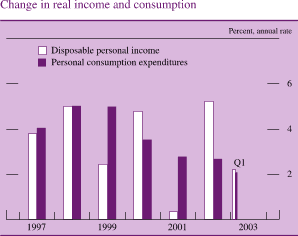
The rise in real consumption expenditures so far in 2003 has about matched the growth in real disposable personal income (DPI), which has been restrained by the poor job market and by the surge in consumer energy prices early in the year. Real DPI rose about 2-1/4 percent at an annual rate between the fourth quarter of 2002 and May after having increased at a considerably faster pace in 2002; the larger increase in real DPI in 2002 in part reflected the effects of the tax cuts enacted in 2001.
Among other key influences on consumption, household wealth grew about in line with nominal DPI in the fourth quarter of 2002 and the first quarter of 2003 after having fallen sharply over the preceding two years. While the rebound in the stock market in the second quarter should help the wealth-to-income ratio recoup some of the ground it lost earlier, households likely have not yet completed the adjustment of their spending to the earlier drop in wealth. Meanwhile, the high level of mortgage refinancing in recent quarters has bolstered consumer spending by allowing homeowners to reduce their monthly payments, pay down more costly consumer debt, and in many cases cash out some of the equity that has accumulated during the upswing in house prices over the past few years. Reflecting these influences, the personal saving rate averaged 3-1/2 percent over the first five months of the year--about the same as the annual average for 2002 but more than 1 percentage point above that for 2001.
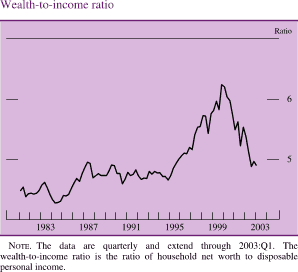
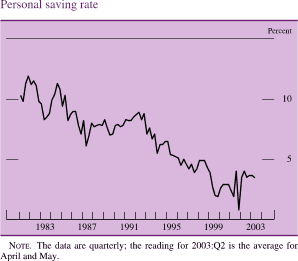
Consumer confidence, which has exhibited some sharp swings in recent years, remained volatile in the first half of 2003. After having declined markedly over the second half of 2002, survey readings from both the Michigan Survey Research Center and the Conference Board took another tumble early this year on concerns about the potential consequences of a war in Iraq. With the combat in Iraq largely over and the stock market recovering, confidence rose appreciably, on net, in the spring.
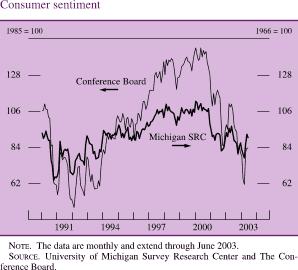
Residential Investment
Housing activity remained robust in the first half of this year, as very low mortgage interest rates apparently offset much of the downward pressure from the soft labor market. In the single-family sector, starts averaged an annual rate of 1.39 million units over the first five months of the year--2 percent greater than the rapid pace for 2002 as a whole. In addition, sales of new and existing homes moved to exceptionally high levels. According to the Michigan survey, consumers’ assessments of homebuying conditions currently are very favorable, mainly because of the low mortgage rates.
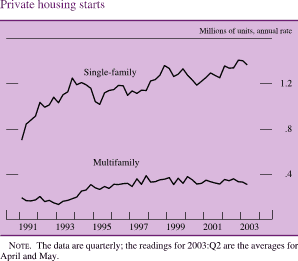
The available indicators provide differing signals on the magnitude of recent increases in home prices, but, in general, they point to smaller gains than those recorded a year or two ago. Notably, over the year ending in the first quarter, the constant-quality price index for new homes rose just 2-1/2 percent, one of the lowest readings of the past few years. Meanwhile, the four-quarter increase in the repeat-sales price index for existing homes, which topped out at 8-1/2 percent in 2001, was 6-1/2 percent in the first quarter. Still, the share of income required to finance the purchase of a new home, adjusted for variations over time in structural characteristics, has continued to move down as mortgage rates have dropped, and it is now very low by historical standards.
Activity in the multifamily sector appears to have slipped somewhat this year, perhaps in part because the strong demand for single-family homes may be cutting into the demand for apartments. Multifamily starts totaled 325,000 units at an annual rate over the first five months of the year, a pace 6 percent below that for 2002 as a whole. In addition, vacancy rates for multifamily rental properties rose further in the first quarter, and apartment rents continued to fall.
Household Finance
Household real estate debt grew rapidly in the first half of the year with the support of the brisk pace of home sales, rising home prices, and falling mortgage interest rates. Indeed, according to Freddie Mac, the average rate on thirty-year conventional home mortgages fell sharply until June, though it has edged back up in recent weeks and now stands at about 5-1/2 percent. Applications for mortgages to purchase homes rose well above the already elevated level of last year. Sales of existing homes, in particular, add significantly to the level of mortgage debt because the purchaser’s mortgage is typically much larger than the seller’s had been. The pace of mortgage refinancing--which adds to borrowing because households often increase the size of their mortgages when they refinance--set consecutive quarterly records in the first and second quarters of 2003 in response to the declines in mortgage rates. According to Freddie Mac, more than 40 percent of the refinancings in the first quarter were "cash-out" refinancings, and the amount of equity extracted likely set a record in the first half of this year. The combination of rising home prices and low interest rates also energized home equity lending during the first half of 2003.
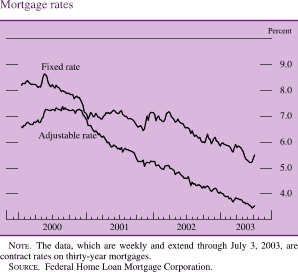
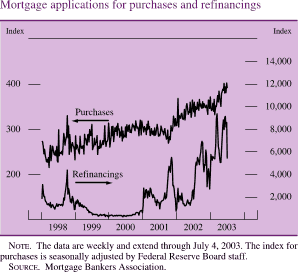
A major use of the proceeds from both cash-out refinancing and home equity loans reportedly has been to pay down credit card and other higher-cost consumer debt. Indeed, in line with those reports, consumer debt advanced at a relatively subdued 4-1/2 percent annual rate in the first quarter. The growth of revolving debt was about 5 percent at an annual rate, and nonrevolving debt expanded at a 3-1/2 percent annual rate. The growth of consumer debt picked up in the spring; the acceleration in part reflected somewhat higher motor vehicle sales that boosted the nonrevolving component, which in turn offset a deceleration in revolving credit. Meanwhile, the average interest rates charged on credit cards and on new car loans at auto finance companies this year have remained near the low end of their recent ranges.
In total, household debt grew at a 10 percent annual rate in the first quarter, a pace about unchanged from last year’s. Despite the marked rise of this debt over the past several quarters, the aggregate debt-service burden of households ticked down in both the fourth quarter of 2002 and the first quarter of this year--periods during which borrowing rates fell and the average maturity of household debt rose. Although households continued to borrow at a rapid pace in the second quarter, the declines in mortgage interest rates and an elevated level of refinancing imply that the debt-service burden was likely little changed.
The credit quality of household debt remained fairly stable in the first quarter. The delinquency rates both on residential mortgages and on credit card loans edged down in the first quarter, though persistently high delinquencies among subprime borrowers remain a problem area. Delinquency rates on auto loans at captive finance companies have edged up in recent months from their very low levels of the past few years. However, lenders probably anticipated some increase as the plethora of new vehicle loans issued in late 2001 and early 2002 seasoned. The fact that a large number of households declared bankruptcy in the first half of the year suggests that some households continue to experience considerable distress.
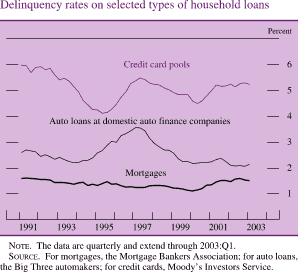
In a continuation of the trend during the second half of 2002, households invested heavily in bond mutual funds--and relatively safe bond funds at that--during the first quarter of 2003 and disinvested from equity funds. However, starting in March, households showed a growing willingness to purchase shares of riskier funds. As corporate credit quality improved and risk-free interest rates fell to record lows, a significantly larger portion of the investment in bond mutual funds flowed into corporate bond funds--including high-yield funds--at the expense of government bond funds. Inflows to equity mutual funds reportedly resumed in mid-March and continued through June.
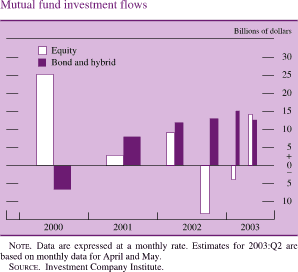
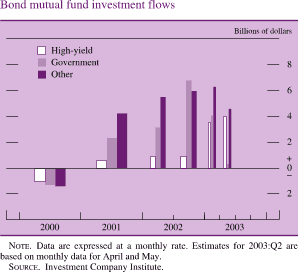
The Business Sector
Fixed Investment
Investment in equipment and software (E&S) continues to languish. Firms reportedly remain reluctant to undertake new projects because of the uncertainty about the economic outlook and heightened risk aversion in the wake of last year’s corporate governance and accounting problems. Excess capacity--in addition to being a factor weighing on nonresidential construction--also is limiting demand for some types of equipment, most notably in the telecommunications area. But other key determinants of equipment spending are reasonably favorable. The aggressive actions taken by firms over the past few years to boost productivity and trim costs have provided a lift to corporate profits and cash flow. In addition, low interest rates and a rising stock market are helping hold down firms’ cost of capital, as is the partial-expensing investment tax incentive. In addition, technological advances continue to depress the relative price of computers at a time when stretched-out replacement cycles have apparently widened the gap between the latest technology and that embodied in many of the machines currently in use.
Real spending on E&S fell at an annual rate of nearly 5 percent in the first quarter. The outlays were restrained by a sharp decline in spending on transportation equipment, especially motor vehicles; excluding that category, spending posted a small gain. Real outlays on high-tech equipment and software rose at an annual rate of about 11 percent in the first quarter, a bit faster than they had in 2002. Real purchases of computers and peripheral equipment remained on the moderate uptrend that has been evident since such spending bottomed out in 2001, and outlays on communications equipment picked up after an extended period of weakness. Meanwhile, investment outside the transportation and high-tech areas dropped back a bit.
Real E&S spending appears to have turned up in the second quarter, in part because of a step-up in the pace of real computer investment. However, incoming data suggest that outlays on communications equipment did not repeat their first-quarter spurt. The data on shipments of capital goods point to moderate increases in spending outside of high-tech and transportation in the second quarter; moreover, backlogs of unfilled orders for equipment in this broad category have risen some this year after having declined over the preceding two years.
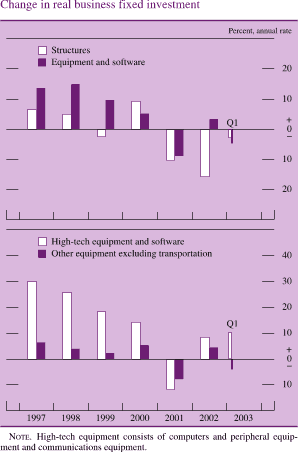
Nonresidential construction remained weak in the first half of 2003. Although real construction outlays were off only a little in the first quarter, they had fallen nearly 16 percent in 2002, and partial data for the second quarter point to continued softness. The downturn in spending has been especially pronounced in the office sector, where vacancy rates have surged and rents have plunged. Spending on industrial facilities also has fallen dramatically over the past couple of years; it has continued to contract in recent quarters and is unlikely to improve much in the absence of a significant rise in factory operating rates. Construction expenditures on other commercial buildings (such as those for retail, wholesale, and warehouse space), which had declined less than did outlays for other major categories of nonresidential construction over the past couple of years, moved up in the first quarter of 2003, but they too have shown some renewed softness lately. One bright spot is the drilling and mining sector, in which outlays have risen sharply this year in response to higher natural gas prices.
Inventory Investment
Most businesses have continued to keep a tight rein on inventories after the massive liquidation in 2001. Real inventory investment in the first quarter was a meager $5 billion at an annual rate and occurred entirely in the motor vehicle industry, where sagging sales and ambitious production early in the year created a noticeable bulge in dealer stocks, especially of light trucks. In the second quarter, the automakers reduced assemblies and expanded incentives to bolster sales, but these steps were sufficient only to reduce stocks a little, and inventories remained high relative to sales through June. Apart from the motor vehicle industry, firms reduced stocks, on net, over the first five months of 2003, and, with only a few exceptions, inventories appear reasonably well aligned with sales.
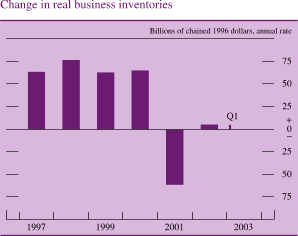
Corporate Profits and Business Finance
Before-tax profits of nonfarm, nonfinancial corporations grew at a 6-1/2 percent annual rate in the first quarter of 2003, and they constituted 8-1/2 percent of the sector’s first-quarter GDP, the highest proportion since the third quarter of 2000. Focusing on the companies that make up the S&P 500, earnings per share for the first quarter were up about 7 percent at a quarterly rate from the fourth quarter of 2002 and were 11 percent higher than four quarters earlier. Although oil companies accounted for the majority of the four-quarter increase, earnings from the financial, utility, and consumer durable sectors were also strong and exceeded the market’s conservative expectations by larger-than-usual margins. The recent depreciation of the dollar substantially boosted revenues of U.S. multinational corporations, but the hedging of currency risk likely limited the extent to which sales gains showed through to profits.
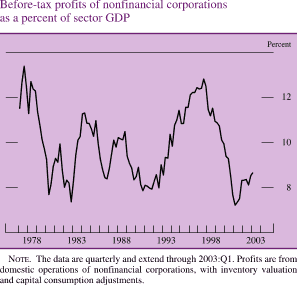
Net equity retirements in the first quarter of 2003 were probably a shade larger than in the fourth quarter of 2002, as the decline in gross new issuance more than offset lower gross retirements. Equity retirements from cash-financed mergers were a bit below their pace in the past two years, and share repurchases appear to be running somewhat slower as well. Volatile and declining equity prices in the first quarter brought initial public offerings (IPOs) to a standstill during the first four months of this year. One small IPO was undertaken in May, and another one came to market in June. With regard to seasoned equity offerings, a war-related lull in March and April held the average monthly pace of issuance this year well below last year’s level. Most of these offerings have been from energy firms and utilities that have used the proceeds primarily to reduce leverage and increase liquidity.
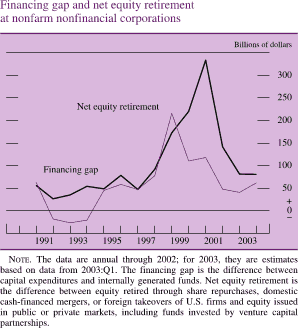
The net debt growth of nonfinancial corporate business was just 3 percent at an annual rate in the first quarter, as rising profits and lower outlays for fixed and working capital held down corporations’ need for external funds. Nonetheless, low interest rates continued to attract firms to the bond market during the first half of 2003, and issuance ran well ahead of its rate of the second half of 2002. Moreover, a large fraction of the issues were from below-investment-grade firms, which likely were responding to the even sharper fall in their borrowing rates than investment-grade firms enjoyed. A substantial portion of the proceeds of recent bond issues have been slated to pay down commercial paper and commercial and industrial (C&I) loans, and each of those components contracted markedly during the first half of the year. Another factor contributing to the weakening in demand for C&I loans this year was the absence of merger and acquisition activity, according to the Federal Reserve’s Senior Loan Officer Opinion Survey on Bank Lending Practices.
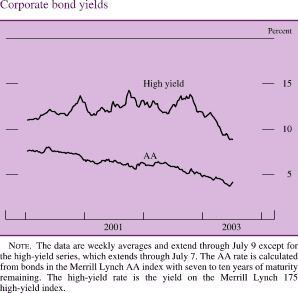
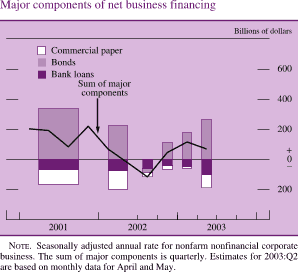
The runoff in C&I loans appears related more to a decrease in demand than to a tightening of supply conditions, and bank credit appears to remain available for qualified business borrowers. The net fraction of banks in the Senior Loan Officer Opinion Survey that reported having tightened lending standards and terms on C&I loans during the first part of the year decreased markedly, and the Survey of Small Business by the National Federation of Independent Business showed that the net percentage of small businesses believing credit had become more difficult to obtain hovered near the middle of its recent range. Moreover, in the April Senior Loan Officer Opinion Survey, a number of banks reported that they had eased lending terms in response to increased competition for C&I loans from nonbank lenders. Indeed, data from Loan Pricing Corporation indicate that nonbank financial institutions purchased a record amount of new syndicated loans during the first quarter of this year; the buyers were reportedly attracted in part by improving liquidity in the secondary loan market.
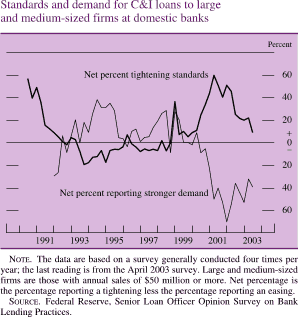
The decline in both short- and long-term interest rates, combined with slow increases in total business debt, contributed to a further reduction in the net interest burden of nonfinancial corporations during the first quarter. Moreover, by issuing bonds and paying down short-term debt, businesses have substantially lengthened the overall maturity of their debt, thus reducing their near-term repayment obligations. These developments, together with higher profitability, have helped most measures of corporate credit performance to improve this year. The number of ratings downgrades continued to exceed upgrades but by a notably smaller margin than last year. The six-month trailing bond default rate declined considerably in the first half of the year. The four-quarter moving average of recovery rates on defaulted bonds improved a bit in the first quarter, although it remained at the low end of its range of the past several years. The delinquency rate on C&I loans at commercial banks also moved down some in the first quarter, albeit to a level well above that of the late 1990s.
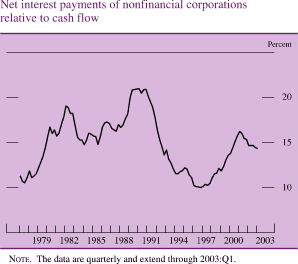
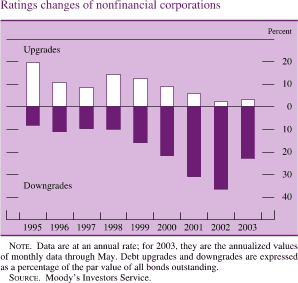
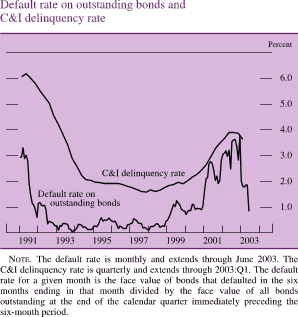
Commercial Real Estate
The growth of debt backed by commercial real estate remained robust this year despite some deterioration in that sector’s underlying fundamentals. In the first quarter of 2003, the expansion of debt was driven by lending at commercial banks and was spread about equally across broadly defined types of commercial real estate loans. Although the issuance of commercial-mortgage-backed securities (CMBS) slowed somewhat in the first quarter from the rapid pace of the second half of last year, issuance appears to have rebounded strongly in the second quarter.
Despite continued increases in vacancy rates and declines in the rents charged for various types of commercial properties, the credit quality of commercial mortgages has yet to show appreciable signs of deterioration. At commercial banks, delinquency rates on commercial mortgages edged up only slightly in the first quarter of 2003 from their historically low levels of recent years. Delinquency rates on CMBS, which were stable in 2002 at about the midpoint of their recent range, have also risen just a bit this year. Respondents to the April 2003 Senior Loan Officer Opinion Survey attributed the resiliency of the credit quality of commercial real estate loans in part to borrowers’ ability to refinance at lower interest rates; they also mentioned that the many borrowers with substantial equity positions in the mortgaged properties have an extra incentive to remain current. Banks also pointed to their having tightened lending standards and terms, including maximum loan-to-value ratios, well in advance of the current downturn.
In line with the assessment that, to date, credit quality in the sector remains good, spreads on CMBS over Treasuries have remained in the lower half of the ranges observed over the past few years. Market reports indicate that CMBS issuers generally have had access to terrorism insurance for the underlying properties, and the cost of that insurance has come down significantly. In addition, newly formed pools that include high-profile properties reportedly have been diversified to further protect investors from losses due to acts of terrorism.
The Government Sector
Federal Government
The federal budget deficit has widened significantly as a consequence of the persistent softness in receipts and legislative actions affecting both spending and taxes. Over the first eight months of the current fiscal year--October to May--the deficit in the unified budget was $292 billion, nearly $150 billion larger than that recorded during the comparable period last year. Moreover, recent policy actions are projected to boost the deficit significantly over the remainder of the fiscal year. In particular, receipts will be reduced appreciably by several provisions of the Jobs and Growth Tax Relief Reconciliation Act of 2003, including advance refund checks for the 2003 increment to the child tax credit, downward adjustments to withholding schedules for individual taxpayers, and the sweetening of the partial-expensing investment incentive for businesses. In addition, outlays will be boosted by the supplemental appropriations for defense and foreign aid and by additional grants to the states. If the latest projection from the Congressional Budget Office is realized, the unified deficit will increase from $158 billion in fiscal 2002 to more than $400 billion in fiscal 2003.
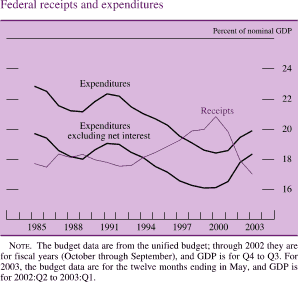
The deterioration in the unified budget has been mirrored in a sharp downswing in federal saving--essentially, the unified surplus or deficit adjusted to conform to the accounting practices followed in the national income and product accounts (NIPA). Indeed, net federal saving, which accounts for the depreciation of government capital, fell from a high of a positive 2 percent of GDP in 2000 to a negative 2-1/2 percent of GDP in the first quarter of 2003. With little change, on balance, in nonfederal domestic saving over this period, the downswing in federal saving showed through into net national saving, which was equal to less than 1 percent of GDP in the first quarter, compared with the recent high of 6-1/2 percent of GDP in 1998. If not reversed over the longer haul, such low levels of national saving could eventually impinge on the formation of private capital that contributed to the improved productivity performance of the past half-decade.
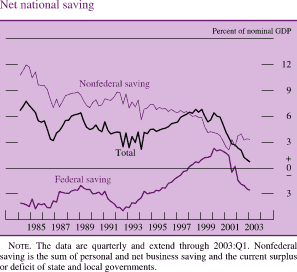
Federal receipts in the first eight months of the current fiscal year were nearly 3 percent lower than during the comparable period of fiscal 2002 after adjusting for some shifts in the timing of payments during the fall of 2001. Individual receipts were especially weak: Although withheld taxes, which tend to move in line with wages and salaries, held up fairly well (after adjusting for changes in tax law) during this period, nonwithheld payments, which are more sensitive to capital income, dropped sharply. This spring’s net final payments, which are largely payments on the previous year’s liabilities, were exceptionally soft for a second year in a row; in combination with the information on withheld and estimated payments, they imply that individual liabilities continued to shrink as a percentage of the NIPA tax base in 2002. The substantial drop in the ratio of liabilities to NIPA income over the past couple of years reflects in part a reversal of the capital gains bonanza of the late 1990s and the tax reductions enacted in 2001. (Capital gains are not included in the NIPA income measure, which, by design, includes only income from current production.) In addition, the change in the distribution of income in the late 1990s, which concentrated more income in the upper tax brackets, may have been reversed some during the past couple of years.
Federal spending during the first eight months of fiscal year 2003 was 6-1/2 percent higher than during the same period last year; excluding the drop in net interest outlays, spending was more than 7-1/2 percent higher. Spurred by the war in Iraq, defense spending has moved up another 15 percent thus far this year; outlays for homeland security have risen briskly as well. Expenditures for income security programs, which include the temporary extended unemployment compensation program, also have risen at a fairly rapid rate. Though growth in spending on Medicare and Medicaid, taken together, has slowed a bit this year, the rising cost and utilization of medical care continue to put upward pressure on these programs.
Expenditures for consumption and gross investment, the part of federal spending that is included in GDP, rose just slightly in real terms in the first quarter as a sizable increase in nondefense purchases was nearly offset by a surprising decline in defense spending. The dip in defense spending followed several quarters of large increases; with the supplemental appropriation in place, defense spending in the second quarter appears to have resumed its rapid growth.
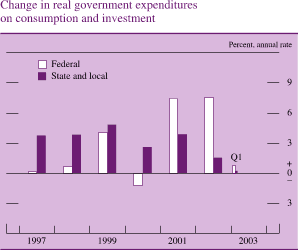
Federal debt held by the public advanced at a 2-1/4 percent annual rate in the first quarter and remained at just below 35 percent of nominal GDP. During the first half of the year, the Treasury announced several changes in its debt management, including the reintroduction of three-year notes and regular reopenings of certain five-year and ten-year notes, to position itself better to address the widening federal deficit. These steps have the consequences of lengthening the average maturity of its outstanding debt and trimming the size of some of its auctions. The Treasury also noted that it would be increasing the frequency and size of its auctions of inflation-indexed securities.
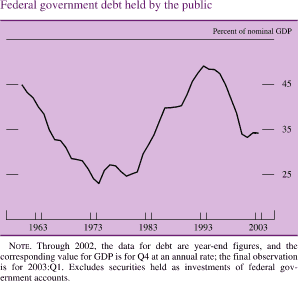
Beginning in February 2003, the Treasury needed to take steps to avoid exceeding the level of the statutory debt ceiling and employed several accounting devices to which market participants have become accustomed. It also temporarily suspended the issuance of the type of Treasury debt instrument in which the proceeds of advance refundings by state and local governments are allowed to be invested. No adverse reaction in financial markets was apparent during this period, however, and a bill increasing the debt ceiling $984 billion, to $7.384 trillion, was enacted on May 23.
State and Local Governments
On the whole, the budget situation at state and local governments remains grim. Like the federal government, states and localities were running sizable budgetary surpluses in the late 1990s and now face large deficits. After having enacted a series of tax reductions in the second half of the 1990s, they subsequently saw their receipts eroded by weak incomes and the falling stock market. At the same time, these entities boosted their outlays considerably, in large part because of rising health care costs and increased demands for security-related spending. The fiscal difficulties have been especially acute at the state level. And although local governments generally have fared somewhat better, many are now facing reductions in assistance from cash-strapped states. According to the NIPA, the state and local sector’s aggregate current deficit rose to about $50 billion in 2002--or 1/2 percent of GDP, the largest annual deficit relative to GDP on record--and that gap exceeded $65 billion at an annual rate in the first quarter of 2003.
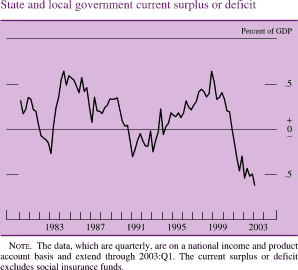
Almost all states and most localities are subject to balanced budget and other statutory rules that force them to address fiscal imbalances. These rules typically apply to operating budgets, and governments have taken a variety of actions to meet their budgetary requirements for fiscal 2003 and to pass acceptable budgets for fiscal 2004, which started on July 1 in most states and many localities. Strategies have included drawing upon accumulated reserves, issuing bonds, and, in some cases, using one-time measures such as moving payments into the next fiscal year and selling assets. Increases in taxes and fees also have become more widespread. Still, spending restraint has remained an important component of the adjustment. Governments--especially at the state level--have held the line on hiring and have limited their outlays for a variety of other goods and services. In the NIPA, real expenditures for consumption and gross investment in the state and local sector rose only 1/2 percent over the year ending in the first quarter, compared with increases averaging more than 3-1/2 percent per year over the preceding five years. Available data point to continued softness in such spending in the second quarter.
The pace of gross issuance of municipal bonds remained robust in the first half of the year; it was fueled in part by the needs of state and local governments to finance capital spending, which is not subject to balanced budget requirements. Long-term debt issuance was heavily used for new education and transportation projects. Declining yields on municipal debt and high short-term borrowing demands also provided important impetus to debt issuance. Despite continued fiscal pressures on many state and local governments, the credit quality of municipal bonds has shown some signs of stabilizing. Although the spread of BBB-rated over AAA-rated municipal bond yields has widened somewhat, the number of municipal bond upgrades by S&P has slightly exceeded the number of downgrades so far this year. The yields on municipal bonds declined more slowly than the yields on Treasury securities of comparable maturity over much of the first half of the year; these moves lowered the yield differential from the tax-advantaged status of municipal securities.
The External Sector
Trade and the Current Account
In the first quarter of 2003, the U.S. current account deficit amounted to $544 billion at an annual rate, or about 5 percent of GDP, a somewhat higher percentage than in any quarter of last year. The deficit on trade in goods and services widened $22 billion in the first quarter, to $486 billion, as the value of imports rose more than that of exports. U.S. net investment income registered a $16 billion surplus in the first quarter, little changed from the previous quarter but significantly larger than the outcome for last year as a whole. The increase over last year is attributable primarily to lower net interest and dividend payments. Net unilateral transfers and other income were a negative $74 billion, down from a negative $67 billion in the fourth quarter.
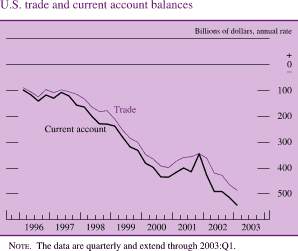
Real exports of goods and services fell 1-1/4 percent at an annual rate in the first quarter; this decline, like that in the previous quarter, reflected in part slow economic growth of our major trading partners. Within this total, exports of goods increased nearly 2 percent after declining sharply in the fourth quarter of last year. Moderate increases in most trade categories were partly offset by a decrease in exports of capital goods (particularly aircraft and computers). Meanwhile, real exports of services declined about 8 percent in the first quarter, mainly because of a drop in receipts from foreign travelers. Prices of exported goods and services, which rose nearly 4 percent at an annual rate in the first quarter, were boosted by rising prices of services and industrial supplies (mainly goods with a high energy component). Prices of exported capital goods, automotive products, and consumer goods showed little change in the first quarter.
U.S. real imports of goods and services declined 6-1/4 percent at an annual rate in the first quarter following four quarters of increases. Imports of oil, other industrial supplies, aircraft, and services (primarily U.S. travel abroad) all dropped sharply. Imports of automotive products decreased for the second consecutive quarter, but imports of machinery and consumer goods rose. The price of imported goods jumped 12 percent at an annual rate in the first quarter, mainly resulting from spikes in the prices of natural gas and oil. The price of imported goods excluding fuels rose about 2 percent in the first quarter, the fourth consecutive quarter of small increases, in part because of the depreciation of the dollar since early 2002. Slight declines in prices of imported capital goods, automotive products, and consumer goods were offset by small increases in other categories.
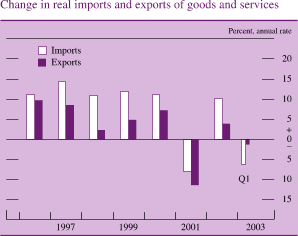
The spot price of West Texas intermediate crude oil rose to a twelve-year high of nearly $38 per barrel in mid-March as the United States moved closer to war in Iraq and as a nationwide strike slowed Venezuelan oil production to a trickle. With the commencement of military action in Iraq and the relatively rapid conclusion of the war, prices fell to less than $26 per barrel by late April. Downward pressure on prices was also exerted by increased production from some OPEC countries, particularly Saudi Arabia, Kuwait, and Venezuela, where oil production recovered substantially relative to the first quarter. In early June, oil prices moved back above $30 per barrel after it became apparent that Iraqi exports of oil would return more slowly than market participants had previously expected.
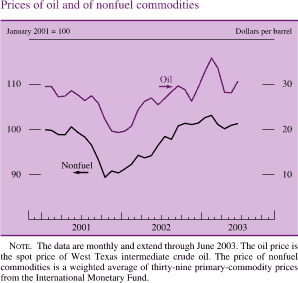
The Financial Account
The U.S. current account deficit continued to be financed in large part by private flows into U.S. bonds and by foreign official inflows. Private foreign purchases of U.S. securities, which slowed in the latter part of 2002, stepped down a bit more in the first quarter of 2003, owing in part to weaker demand for U.S. equities. In contrast, inflows into the United States from official sources, which surged in 2002, picked up further in the first half of 2003 partly in response to downward pressures on the foreign exchange value of the dollar. U.S. residents, who had sold foreign securities on net last year, recorded sizable net purchases in the first quarter of this year: Relatively large purchases of foreign equities outweighed further sales of bonds.
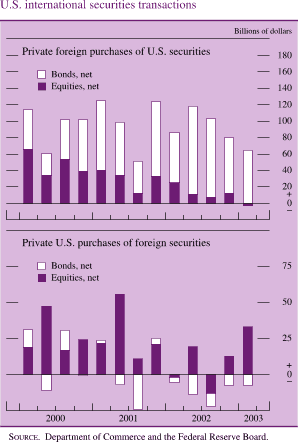
Direct investment into the United States, after being restrained in 2002 by a slowdown of global mergers and acquisitions, picked up in the first quarter of 2003, as merger activity resumed. U.S. direct investment abroad was steady in 2002 and the first quarter of 2003.
The Labor Market
Employment and Unemployment
The demand for labor has weakened further this year, though the pace of job losses appears to have slowed somewhat. After having fallen an average of 55,000 per month in 2002, private payroll employment declined 35,000 per month, on average, in the first quarter of 2003 and 21,000 per month in the second quarter. The civilian unemployment rate, which had been fluctuating around 5-3/4 percent since late 2001, was little changed in the first quarter but moved up in the spring. In June, it stood at 6.4 percent.
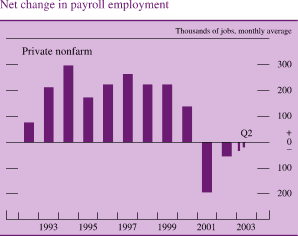
The manufacturing sector has continued to shed jobs this year. On average, factory payrolls fell 55,000 per month over the first half of 2003--essentially as fast as over 2002 as a whole. Employment declines were widespread, but the metals, machinery, and computers and electronics industries continued to be especially hard hit. The weakness in manufacturing also cut into employment at help-supply firms and at wholesale trade establishments, although help-supply jobs increased noticeably in May and June.
Apart from manufacturing and related industries, private employment increased slightly, on net, in the first half after having been about unchanged in 2002. Employment in the financial activities sector rose briskly, in part because of the boom in mortgage refinancings. Construction employment, which had been essentially unchanged, on net, since 1999, remained soft in the first quarter but posted a sizable gain in the second quarter. Employment in the information sector, which includes telecommunications, publishing, and Internet-related services, continued to decrease, though a shade less rapidly than over the preceding two years. Demand for workers in retail trade, leisure and hospitality, and transportation and utilities remained lackluster.
The unemployment rate was little changed in the first quarter, but it subsequently turned up. In June, it stood at 6.4 percent, 1/2 percentage point higher than the average in the fourth quarter of 2002 and about 2-1/2 percentage points above the lows reached in 2000. The rise in the unemployment rate over the spring was chiefly driven by the ongoing softness in labor demand. Most recently, it also coincided with an uptick in labor force participation. That uptick notwithstanding, the participation rate has trended down over the past couple of years, a slide mainly reflecting declines for adult men and younger persons.
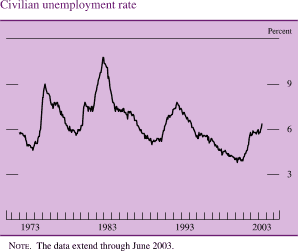
Productivity and Labor Costs
Labor productivity has continued to post solid gains in recent quarters as businesses have remained reluctant to expand their payrolls and instead have focused on cutting costs in an environment of sluggish--and uncertain--demand. According to the currently published data, output per hour worked in the nonfarm business sector rose at an annual rate of 2 percent in the first quarter and 2-1/2 percent over the four quarters ending in the first quarter. Though the recent gains are down from the very rapid increases in late 2001 and 2002, they are similar to those achieved in the second half of the 1990s. However, whereas the earlier productivity gains were driven importantly by an expansion of the capital stock, the recent gains appear to have come mainly from efficiency-enhancing changes in organizational structures and better use of the capital already in place.
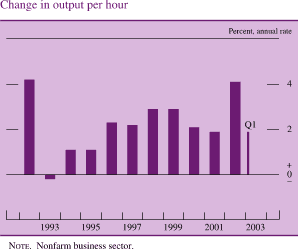
The employment cost index (ECI) for private nonfarm businesses increased about 3-3/4 percent over the twelve months ending in March--only a shade less than over the preceding year but more than 1/2 percentage point below the increases of a few years earlier. The deceleration in hourly compensation over the past few years has been concentrated in wages, for which gains slowed from about 4 percent per year in 2000 and 2001 to 3 percent over the year ending this March. The slowing in wage growth primarily reflects the effects of the soft labor market and lower rates of price inflation; in addition, employers may be exerting more restraint on wages to offset some of the upward pressure on total compensation from rising benefit costs. The increase in benefits was especially sharp in the first quarter of 2003; in that period, employers stepped up their contributions to defined-benefit retirement plans in response to declines in the market value of plan assets, and health insurance costs continued to increase rapidly. In total, benefit costs rose 6 percent over the year ending in March.
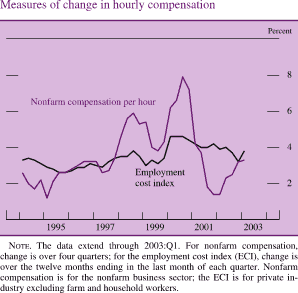
The growth in compensation per hour in the nonfarm business sector--an alternative measure of hourly compensation based on the NIPA--has swung widely in recent years. Fluctuations in the value of stock option exercises, which are excluded from the ECI, likely have contributed importantly to these swings. In any event, the increase in this measure over the year ending in the first quarter was 3-1/4 percent and roughly in line with the rise indicated by the ECI.
Prices
Headline inflation numbers have been heavily influenced by movements in energy prices, but underlying inflation has remained subdued and according to some measures has even moved somewhat lower. Reflecting the surge in energy prices, the chain-type price index for personal consumption expenditures (PCE) increased at an annual rate of 2-3/4 percent in the first quarter, about 1 percentage point faster than the increase over 2002 as a whole; this index moved down in April and May as energy prices retreated. PCE prices excluding food and energy--the so-called core PCE price index--were nearly unchanged during the spring, and the twelve-month change in this series stood at 1-1/4 percent in May, compared with a reading of 1-3/4 percent over the preceding twelve months.
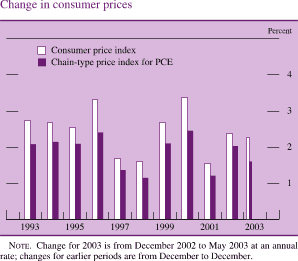
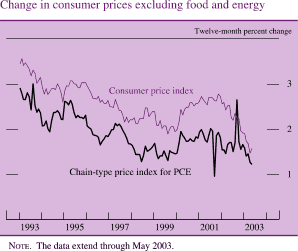
In the main, the quiescence of underlying inflation reflects continued slack in labor and product markets and the robust productivity gains of recent years. In addition, inflation expectations have remained in check--and, indeed, may have subsided a bit further. For example, according to the Michigan Survey Research Center, the median expectation for inflation over the coming year was running about 2 percent in May and June, compared with 2-1/2 percent to 3 percent over much of the preceding few years. Readings on this measure had been considerably higher earlier in the year, when energy prices were rising, and it is difficult to know whether the decline of late was driven chiefly by the retreat in energy prices during the spring. Non-oil import prices posted a sizable increase in the first quarter after having been little changed in 2002, but the first-quarter rise was due largely to a spike in the price of imported natural gas, which should not have much effect on core consumer price inflation. Given the decline in the dollar from its peak in early 2002, non-oil import prices will probably trend up modestly in coming quarters.
PCE energy prices rose sharply in the first quarter but turned down in the spring, a pattern largely mirroring the swings in crude oil prices. Gasoline prices, which had already been elevated in late 2002 by weather-related supply disruptions, increased further early this year as crude oil costs rose and wholesale margins remained large; by June 1, gasoline prices had reversed that increase, and they have changed little, on net, since that time. Natural gas prices also soared in early 2003 as tight inventories were depleted further by unusually cold weather; since the unwinding of February’s dramatic spike, prices have held in a narrow range. Inventories of natural gas have increased significantly of late, but they are still low enough to raise concerns about the possibility of future price spikes in the event of a heat wave later this summer or an unusually cold winter. Reflecting the higher natural gas input costs, PCE electricity prices rose substantially over the first five months of 2003 after having fallen some in 2002.
Increases in core consumer prices of both goods and services have slowed over the past year, with the deceleration most pronounced for goods. Prices for core PCE goods fell 2-1/4 percent over the year ending in May after having decreased 1 percent over the preceding twelve months. Meanwhile, the rise in prices for non-energy services totaled 2-3/4 percent over the year ending in May, a little less than over the preceding period. Among the major types of services, the price of owner-occupied housing was up only 2-1/2 percent after having risen 4-1/4 percent over the preceding period. But prices for some other types of services accelerated. Most notably, the prices of financial services provided by banks without explicit charge turned up after having decreased over the preceding two years; because these prices cannot be derived from market transactions and thus must be imputed, they are difficult to measure and tend to be volatile from year to year.
Increases in the core consumer price index (CPI) also have been very small recently, and the twelve-month change in this measure slowed from 2-1/2 percent in May 2002 to 1-1/2 percent in May 2003--a somewhat greater deceleration than in core PCE prices. The greater deceleration in the CPI is primarily accounted for by its narrower scope and different weighting structure than the PCE measure. In particular, it excludes the imputed prices of financial services rendered without explicit charge as well as several other categories for which market prices are not available; these non-market-based prices have accelerated notably recently. In fact, when the nonmarket categories are stripped from the core PCE index, the remaining components show a deceleration close to that in the core CPI. Another consideration is that housing costs have a much larger weight in the CPI than in the PCE index, partly because of the CPI’s narrower coverage. Thus, the smaller price increases for housing services of late have a bigger damping effect on core CPI inflation, just as the hefty increases in this category in 2001 and 2002 tended to lift the CPI relative to the PCE index.
